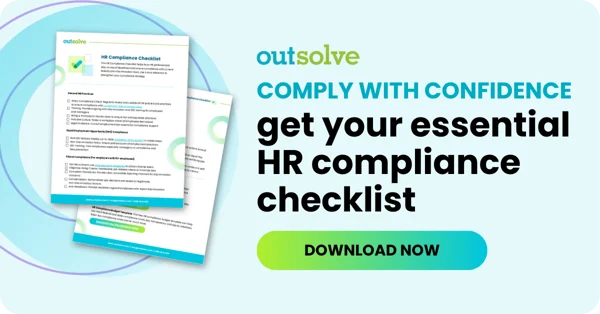6 min read
HR Compliance Nightmares: Fixing The Inherited Messes You Didn't Create
 John Piatt, SHRM-SCP
:
Nov 13, 2025 12:45:09 PM
John Piatt, SHRM-SCP
:
Nov 13, 2025 12:45:09 PM

You stepped into your new HR role ready to make an impact. But instead of a smooth onboarding, you found a pile of human resource problems no one warned you about: missing I-9s, outdated job descriptions, inconsistent compensation structures and practices, zero documentation for veterans programs, and no clear record of outreach efforts.
Sound familiar?
You’re not the first person inheriting HR compliance issues. In fact, most compliance programs aren’t built to withstand turnover. According to a recent study, only 33% of employers say their employment law compliance processes are mature and fully understood. The rest? A patchwork of inconsistent documentation, outdated systems, and limited institutional knowledge. Those legacy issues create real risk, including fines, failed audits, internal complaints, and even legal exposure.
This is more common than you think, though. The good news is that it’s fixable with the right strategy. In this guide, we’ll walk through how to identify inherited HR compliance risks, take control of the situation, and build systems that keep your organization protected going forward.
What HR Compliance Nightmares Look Like
Inherited compliance issues rarely announce themselves. Most stay hidden until you get hit with an audit, a fine, or an employee complaint. Here are some of the most common issues HR professionals walk into, often unknowingly:
- Outdated or incomplete I-9 forms — sometimes missing entirely, often verified outside of the legal time frame, missing key elements, or stored improperly.
- Incomplete or Unmaintained Affirmative Action Plans – missing or outdated AAPs for the current year
- Missing documentation of job postings or outreach efforts — especially for federal contractors who must prove listing activity with the State Employment Service (ESDS).
- Inaccurate or unfiled EEO-1 reports— with no centralized owner or updated demographic tracking.
- Unlawful or noncompliant DEI programs— particularly in the wake of changing executive orders and increased scrutiny around “preference-based” initiatives.
- Pay disparities with no documentation— leading to risk under pay equity or discrimination laws, especially in states like Illinois or California with aggressive enforcement.
- Nonexistent or outdated internal policies— including hiring procedures, applicant tracking, and document retention
- State and Local Law Noncompliance – missing documentation and paper trails
- Missing or Outdated Labor Law Posters – failure to post, update, or provide electronically for remote workers
- AI in hiring – using algorithms without evaluating selection decisions for potential flaws and discrimination
These issues don’t just happen in large corporations or high-risk industries. They happen anywhere there's turnover, weak handoffs, or poor recordkeeping. And they tend to compound quietly, until a regulator or legal team starts asking questions.
Why These Problems Happen
Compliance gaps don’t always result from negligence. More often, they’re a byproduct of organizational change, outdated systems, weak processes, or incomplete handoffs. Here’s why these issues persist long after the previous HR team has moved on:
- Staff turnover without documentation — Institutional knowledge walks out the door when HR leaders leave. Without formal documentation or handoff procedures, new HR professionals are left to guess what has been done and what has been missed.
- No centralized system for compliance tracking — If key compliance data (like I-9s, outreach logs, and pay equity documentation) is stored in shared drives, individual inboxes, or spreadsheets, there’s no reliable way to track or prove compliance.
- Outdated or missing policies and procedures — Hiring practices, job descriptions, pay structures, and diversity programs can become noncompliant quickly if they’re not reviewed regularly. This is especially risky as federal and state regulations are constantly changing.
- Limited or no internal audits — Without periodic internal audits for things like pay equity or I-9s, companies often remain unaware of gaps until a regulator, auditor, or plaintiff highlights them. Some organizations avoid audits altogether. That’s assuming no news means no problems.
- Processes exist in people’s heads, not in writing — If there’s no standardized, written process for hiring, onboarding, recordkeeping, or reporting, the entire system is vulnerable. When key personnel leave, the “how” leaves with them.
While these gaps may not be your fault, they unfortunately become your responsibility. Whether caused by turnover, poor documentation, or outdated systems, inherited compliance issues can’t be ignored. HR leaders are expected to step in, take ownership, and bring clarity to the chaos.
![[OTSLV]-BLOG-interior image-why compliance nightmares happen.png](https://www.outsolve.com/hs-fs/hubfs/%5BOTSLV%5D-BLOG-interior%20image-why%20compliance%20nightmares%20happen.png.png?width=600&height=314&name=%5BOTSLV%5D-BLOG-interior%20image-why%20compliance%20nightmares%20happen.png.png)
Steps to Fix Compliance Issues You Didn’t Create
You’ve found the mess. Now what?
It’s easy to feel overwhelmed when the list of problems keeps growing: outdated forms, undocumented hires, policies that contradict each other (or don’t exist at all). The solution is precision, not raw speed. Move one step at a time and start with what matters most.
1. Conduct a compliance audit to identify gaps
Start with discovery. You’re identifying what’s broken in the system, not just looking for a few missing forms. Some gaps will be obvious (no I-9s for remote hires), while others are more subtle (policies that were never rolled out, or training that quietly stopped two years ago).
Ask more than “Do we have it?” Ask whether it was done right, if it’s current, and whether anyone is actually following it.
If you’re not sure where to start, use an I-9 audit checklist to identify common risks and errors associated with Form I-9 compliance. An HR Compliance Checklist is another great tool to help you identify any compliance gaps.
2. Prioritize issues based on risk and potential penalties
Don’t fall into the trap of fixing the most visible things first. Fix the riskiest.
If there’s a compliance failure that could trigger an audit, a lawsuit, or a regulatory fine, it moves to the top of the list. That might mean correcting pay data errors (or initiating a pay equity audit) before rewriting job descriptions.
Some fires can wait. Others can’t.
3. Update and implement policies and procedures
Here’s where you start rebuilding.
Start with the gaps that caused the compliance issues in the first place. Do you have a hiring process that includes self-ID collection? A consistent promotion review process? Is there a documented way to track outreach for federal jobs, including VETS-4212 reporting?
Write down those pieces in a clean, accessible, and grounded document that reflects your organization's actual work.
4. Train staff to ensure proper documentation and ongoing compliance
You can fix the policies, but unless people know how to use them, nothing changes. This is where compliance efforts live or die.
The training doesn’t have to be long, but it does have to be specific. Teach hiring managers how to document candidate decisions. Show recruiters where and how to track outreach. Make sure HR staff know what records need to be retained and for how long.
And don’t assume once is enough. Make HR team training a regular part of your schedule, just like everything else on your annual calendar.
5. Consider technology solutions for centralized recordkeeping and audit readiness
If your files are scattered across inboxes, shared folders, three different HR systems, and some departed employee’s desktop, you’re always a step away from noncompliance.
You need a home base. Whether that’s a formal HRIS, a third-party compliance provider, or a tightly managed internal system, the goal is the same: consistent, centralized records. Especially for critical areas like I-9s, compensation history, and compliance reporting.
6. Internal comms to employees to improve employee relations
Some of the issues you fix will be invisible. Others won’t be. If employees have noticed inconsistencies, they’re already paying attention.
You don’t need to announce every change, but silence can feel like denial. Communicate clearly when policies are updated. Reinforce that HR’s goal is fairness and clarity. Let people see that the gaps are being closed and that the organization is better for it.
Fixing a broken compliance foundation isn’t glamorous. It’s tedious, sometimes thankless, and almost always invisible to the people who benefit from it. But the work matters. You’re rebuilding trust, not just with regulators but with your workforce as well.
![[OTSLV]-BLOG-interior image-6 steps to fix](https://www.outsolve.com/hs-fs/hubfs/%5BOTSLV%5D-BLOG-interior%20image-6%20steps%20to%20fix.png?width=600&height=314&name=%5BOTSLV%5D-BLOG-interior%20image-6%20steps%20to%20fix.png)
Preventing Future HR Compliance Nightmares
Once you've done the heavy lifting of fixing what you inherited, the next challenge is keeping things from falling apart again. That means building systems that aren’t dependent on any one person, process, or moment in time.
You can’t future-proof everything. But you can build an infrastructure that makes it harder for compliance gaps to grow quietly. Creating a program for your HR team to catch problems before they escalate goes a long way to fixing your overarching processes.
Start by making monitoring routine. That doesn’t mean a massive audit every quarter, but it does mean putting regular reviews on the calendar — checking I-9s, reviewing job posting workflows, making sure DEI is lawful and outreach logs are up to date. This work doesn’t stay clean on its own. You have to make time for it.
The systems you use matter, too. If you’re relying on scattered files, disconnected apps, or someone’s memory to track critical compliance data, you're back where you started. Whether it’s a formal HRIS or a set of clearly managed internal tools, create a structure that supports consistent documentation, shared access, and audit readiness.
If HR processes only exist in your head, they’re a risk. Write it down. Not as a 50-page manual no one reads, but as simple, accessible documentation that makes it easy for the next person to pick up where you left off. Turn your fixes into standards.
Culture plays a role, too. If compliance is seen as a checkbox or someone else’s job, it’ll always be vulnerable. But if people understand why documentation matters — and how it protects them as much as the company — they’re more likely to follow through. Start small: include compliance steps in onboarding. Normalize asking for documentation.
You can’t control what comes after you, but you can leave behind something better than what you found: a system that won’t fall apart the moment you’re out of office.
![[OTSLV]-BLOG-interior image-Preventing future messes.png](https://www.outsolve.com/hs-fs/hubfs/%5BOTSLV%5D-BLOG-interior%20image-Preventing%20future%20messes.png.png?width=600&height=314&name=%5BOTSLV%5D-BLOG-interior%20image-Preventing%20future%20messes.png.png)
Making Compliance Your Own, Even If You Inherited It
Inherited compliance problems are common — and yes, frustrating. But they don’t have to define your role. The most effective HR professionals don’t just put out fires; they create systems that prevent those fires from reigniting, spreading, or causing serious harm.
If you’ve walked into a broken process, here’s what’s worth remembering:
- Fixing legacy issues doesn’t require starting from scratch. It just requires knowing where to look.
- Legal risk isn’t evenly distributed. Prioritize what could get your company fined, audited, or exposed.
- Clear policies and consistent documentation matter more than polished manuals.
- Training is only effective if it addresses the actual gaps you’ve identified, not generic best practices.
- Technology won’t solve everything, but disorganized files will absolutely make it worse.
- Communicate change early and clearly, not just up the chain, but across the organization.
- Consider partnering with OutSolve to outsource your HR compliance tasks to experts. The cost might outweigh the risk of noncompliance.
Getting your house in order takes time. It’s work worth doing, though. That’s not just because someone before you dropped the ball, but because someone after you shouldn’t have to clean it up again.
Ready to tackle a compliance nightmare you didn’t create? Talk to OutSolve’s compliance experts for advice and guidance on creating a compliant system.
John is a graduate from California State University, Chico with a degree in Business Administration and is a Society for Human Resources Management (SHRM) Senior Certified Professional. Throughout his 20 years in EEO consulting, John has served in various leadership roles, conducted training for organizations large and small, presented at the NILG, AAAED, and ILG conferences. He has been a contributor on several industry webinars and author and editor for numerous industry blogs and articles.
Weekly OutLook
Featured Posts

The Federal Government Shutdown Lingers: HR Professionals Take Action

HR Planning: 5 Planning Steps for Q4
Related Posts

HR Compliance Nightmares: Fixing The Inherited Messes You Didn't Create
You stepped into your new HR role ready to make an impact. But instead of a smooth onboarding, you found a pile of human resource problems no one...

CHRO Survival Guide: The Hidden Costs of Deregulation and the Rise of AI in HR Compliance
In Part 1 of our CHRO Survival Guide series, we examined the regulatory “whiplash” caused by a surge of Executive Orders in 2025 and the uncertainty...

Reduce Risk, Not Resources: Why I-9 Verification Should Be Outsourced
Immigration enforcement is back in the spotlight, with employers squarely in the crosshairs. With a growing, large budget for DHS and a renewed focus...


